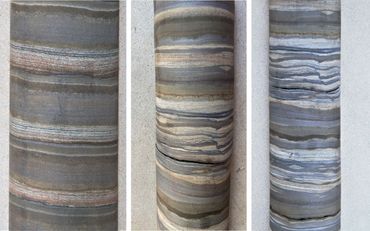
Rise of oxygen in early ocean due to wobbling Earth's axis
NIOZ Royal Netherlands Institute for Sea ResearchMargriet Lantink studied those oxygen fluctuations with an international team of Dutch researchers from Royal Netherlands Institute for Sea Research (NIOZ) and Utrecht University, and published about it in the scientific article Precessional pacing of early Proterozoic redox cycles.
The sudden rise of oxygen
The 'Earth System' worked substantially differently 2.5 billion years ago than it does today. The atmosphere was without oxygen and the oceans were rich in dissolved iron. Single-celled bacteria were the only inhabitants. That changed during the so-called 'Great Oxidation Event'. From about 2.4 to 2.2 billion years ago, in the geological blink of an eye, high levels of oxygen first entered the air and sea water; an event that was crucial to the further development of life on our planet.
Oxygen-free seas
NIOZ researchers' interest in oxygenless or oxygen-rich seas is not limited to the distant past, stresses NIOZ researcher Gert-Jan Reichart, who is also a professor of Marine Geology in Utrecht. "The research is also relevant today because we see oxygen-free zones forming in some parts of the ocean. Although the time scale is very different, the study of fluctuating oxygen levels in seawater from the distant past can give us insights that are useful to better understand the current increase in oxygen-free zones."
Bands of iron

During the study, Lantink and her colleagues looked at 2.46 billion-year-old earth layers in Australia. The pattern of regular 'bands of iron' they found there, appeared to match the rhythm of the earth's spinning and changes in its orbit around the sun. Those bands of iron in turn correspond to the coming and going of oxygen in the oceans.
Oxygen rose and fell
To understand how the pattern of iron deposits from Australia's ancient earth layers emerged, the researchers ran chemical model calculations on the 2.5 billion-year-old ocean floor. Lantink: "We found that periods of high bacterial growth were accompanied by the deposition of iron. The oxygen produced by the bacteria bound to iron, which was then carried away to the bottom as oxide. During periods with less bacterial growth, more iron remained dissolved in the water."
Wobbling Earth's axis
 That coming and going of oxygen and of iron oxide (rust) on the ocean floor appeared to follow the pattern of the so-called Milankovitch cycles. Those cycles describe the variation of Earth's climate due to the wobbling of Earth's rotating axis. Also, the change in the shape of Earth's orbit around the sun is a rhythmically recurring process. During the period of the study, that 'wobble' had a rhythm of 11 thousand years. Today, the Earth's axis wobbles back and forth at a rhythm of 21 thousand years.
That coming and going of oxygen and of iron oxide (rust) on the ocean floor appeared to follow the pattern of the so-called Milankovitch cycles. Those cycles describe the variation of Earth's climate due to the wobbling of Earth's rotating axis. Also, the change in the shape of Earth's orbit around the sun is a rhythmically recurring process. During the period of the study, that 'wobble' had a rhythm of 11 thousand years. Today, the Earth's axis wobbles back and forth at a rhythm of 21 thousand years.
Just the right time
This rhythm influences the Earth's climate, and consequently the coming and going of oxygen in the ancient oceans. "The pattern that became visible in Australia we also recognize in much younger earth layers around the Mediterranean Sea," says Reichart. "This research shows that just before the Great Oxidation Event, 2.5 billion years ago, astronomical conditions were apparently such that oxygen levels were occasionally raised over a threshold. At those times, so much oxygen was produced that the dissolved iron could no longer remove it all as rust to the sea floor."
Coincidence
That this confluence of circumstances occurred may seem like a great coincidence, but it is not. There had always been astronomical influence on Earth's climate. On the continents that had already formed by then, during wet periods, rivers provided runoff with many nutrients. These nutrients led to the recurring blooms of cyanobacteria in the oceans. The resulting production of oxygen eventually led to a huge increase in the Earth's oxygen content. And that turned out to be crucial for the development of complex life on Earth a short time later.
More information
- The scientific publication Precessional pacing of early Proterozoic redox cycles, written by Margriet L. Lantink, Wytze K. Lenstra, Joshua H.F.L. Davies, Rick Hennekam, David McB. Martin, Paul R.D. Mason, Gert-Jan Reichart, Caroline P. Slomp, Frederik J. Hilgen, published in Earth and Planetary Science Letters.
Text: NIOZ
Photos: Frits Hilgen, Utrecht University; Margriet Lantink
